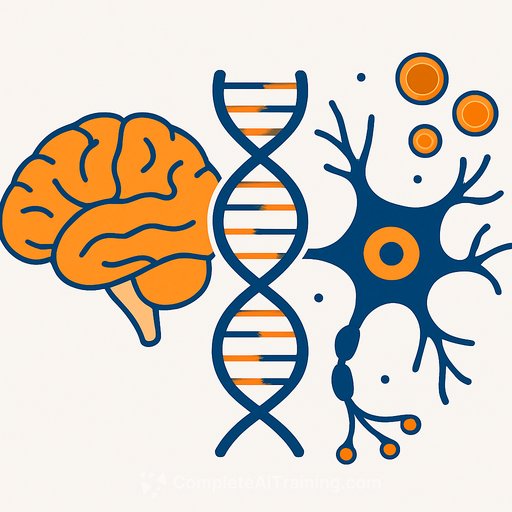Genetic evidence ties Alzheimer's risk to memory-making neurons - not just immune cells
Rice University researchers, with collaborators at Boston University, built a computational tool that links genetic risk to specific cell types with higher precision. The algorithm, called seismic, points to memory-related neurons as key players in Alzheimer's disease, helping resolve a long-standing mismatch between genetic data and what pathologists see in patient brains.
By aligning large-scale genetics (GWAS) with single-cell RNA sequencing data, seismic clarifies how inherited risk translates into cellular vulnerability. The team reports stronger, cleaner signals than prior methods and broad applicability across neurological and metabolic diseases.
What's new
- Tool: seismic (Single-cell Expression Integration System for Mapping genetically implicated Cell types) matches GWAS signals to specific cell types across brain regions.
- Key finding: Genetic links point to memory-making neurons in Alzheimer's, aligning with the neurons that actually die - not just microglia, which prior genetic studies often emphasized.
- Scope: Tested across 28 traits and 1,000+ cell-type characterizations; highlights cell- and region-specific differences in both Alzheimer's and Parkinson's.
- Performance: Outperforms existing approaches in identifying meaningful disease-relevant cellular signals.
Why this matters for researchers
Cell-type specificity is the bridge between statistical associations and actionable biology. If genetic risk concentrates in particular neuron subclasses, it reframes target discovery, biomarker development, and trial design toward those cells and their pathways.
- Sharper hypotheses for mechanisms and interventions (cell types, brain regions, gene programs).
- Improved early-detection strategies rooted in cell-specific markers.
- Better patient stratification by cell-type risk profiles for precision trials.
How seismic works
Seismic integrates GWAS with single-cell RNA-seq to infer which cell types carry the genetic signal for a trait. It addresses two pain points: overly broad cell annotations that blur region-specific biology, and GWAS signals anchored to clinical diagnoses that can overweight immune components.
The framework introduces a specificity score that factors both expression magnitude and consistency, plus an influential gene analysis to flag genes driving each cell type-trait association. The result is a scalable, more interpretable mapping from polygenic risk to cell types.
Results at a glance
- Alzheimer's: Pathology-based GWAS integrated with single-cell data points toward vulnerable neuron populations and their molecular programs.
- Reconciliation: Helps explain why patient DNA often flagged microglia while autopsies showed neuron loss - both can matter, but neuronal vulnerability is now supported by genetics.
- Parkinson's: Highlights cell- and brain-region-specific differences relevant to disease pathways.
- Interpretability: Influential gene analysis identifies candidate drivers for downstream functional studies.
Context: the dementia burden and policy momentum
Globally, an estimated 57 million people lived with dementia in 2021, with ~10 million new cases annually. In the U.S., more than 6 million people are affected, and new cases are projected to double over the coming decades, according to a 2025 study.
In Texas, lawmakers created the Dementia Prevention and Research Institute of Texas (DPRIT). A proposed $3 billion funding measure over the next decade would make it the largest state-funded dementia program, modeled after CPRIT, to accelerate research and prevention.
Practical takeaways for scientists
- Re-assess neuron- versus microglia-centric hypotheses; both may play roles, but neuron vulnerability now carries genetic weight.
- Prioritize pathology-based GWAS when possible to reduce diagnostic noise and sharpen cell-type mapping.
- Use region-resolved single-cell atlases; avoid pooling across brain areas that mask cell-state differences.
- Leverage influential gene outputs to pick targets for CRISPR screens, organoids, or in vivo validation.
- Integrate proteomics and spatial transcriptomics to test whether cell-type signals translate to protein and circuit changes.
Limitations and open questions
- Association isn't causality; functional validation remains essential.
- Ancestry representation in GWAS and single-cell datasets can bias signals; diversify cohorts.
- Cell type vs. cell state: disease-relevant states may be transient and missed without careful sampling.
- Temporal dynamics: early vs. late-stage changes may map to different cell populations.
Access the study and background
- Original research (open access): Nature Communications - "Disentangling associations between complex traits and cell types with seismic" Read the paper
- GWAS overview: NHGRI primer on genome-wide association studies Learn more
Funding and acknowledgments
Supported by NIH (RF1AG054564, R21AG085464), CPRIT (RR190065), the Cure Alzheimer's Fund, and the Karen Toffler Charitable Trust. The authors note that statements are their own and do not represent official views of the funding organizations or institutions.
Source: Rice University
Image credit: Neuroscience News
Build your computational skills
If you're scaling your lab's AI and data analysis capabilities for genetics or single-cell work, explore focused training options: AI certification for data analysis.
Your membership also unlocks:






